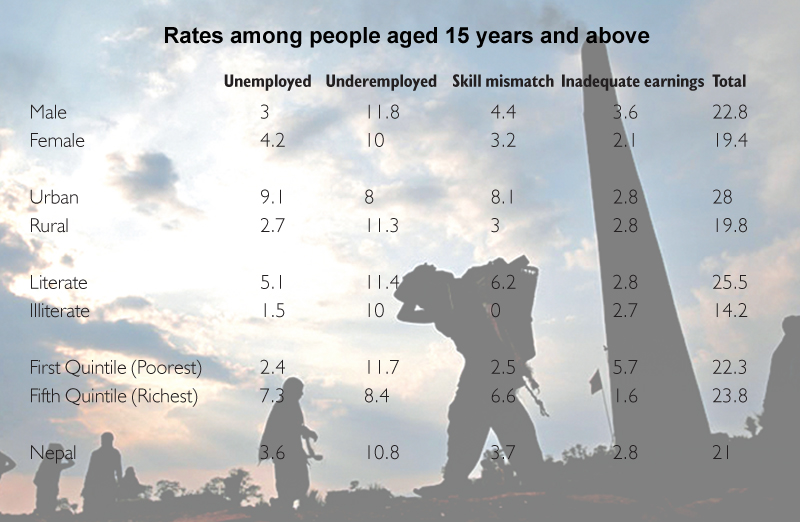Job market data paints a worrying picture
Kathmandu, September 22
Labour underutilisation is high among literate, rich and urban population of the country, meaning these economically active people of working age group are either unemployed, underemployed, earning less as compared to their skills or performing jobs that do not match their skills.
Labour underutilisation rate currently stands at 21 per cent in the country, shows the latest Annual Household Survey conducted by the Central Bureau of Statistics (CBS).
The problem of labour underutilisation is worse in urban areas, where 28 per cent of the labour force is underutilised, shows the survey, conducted among 3,000 households in urban and rural areas.
Of the urban people whose labour remains underutilised, 9.1 per cent are unemployed, eight per cent are underemployed, 8.1 per cent are performing jobs that do not match their skills and 2.8 per cent are earning less as compared to their skills.
Also, labour underutilisation rate is high among the rich people of the country. Labour of at least 23.8 per cent of the economically active people, who fall in the fifth quintile (the richest), remains underutilised. Similarly, labour of 25.5 per cent of the literate population remains underutilised.
Lately, many developing countries have started scrutinising data on labour underutilisation rather than on unemployment as it provides comprehensive information about job market.
Data on unemployment has come under scrutiny in many developing countries because of the definition of employment.
For example, a person who is working for at least an hour in last seven days is considered as employed. This definition has led to recording of lower unemployment rates in developing countries, says the CBS.
In Nepal as well, unemployment rate stands at a mere 3.6 per cent. But another 10.8 per cent of people of working age group, who are economically active, are unemployed. Similarly, 3.7 per cent of the economically active population of working age are performing jobs that do not match their skills and another 2.8 per cent are earning less as compared to their skills.
Unemployment rate is derived from economically active population of working age group. Currently, only around 57 per cent of people of working age group are categorised as economically active population.
The rest, despite falling in working age group, are economically inactive, meaning these people do not want a job, are not looking for one, cannot make themselves available even if they find a work, or rarely work.
The survey also shows 68.8 per cent of employed people are working in agriculture sector, followed by wholesale and retail trade and repair of motor vehicles and motorcycles (seven per cent), and manufacturing sector (6.3 per cent). The scenario is pretty different in urban areas, where only 26.3 per cent of people, who are working, are employed in agricultural sector, followed by wholesale and retail trade and repair of motor vehicles and motorcycles (21.7 per cent), and manufacturing sector (12.5 per cent).
CBS creating new GDP basket
Kathmandu, September 22
The Central Bureau of Statistics (CBS) has initiated the task of revising the base year for calculation of gross domestic product (GDP) and other data on national accounts.
With the revision, new goods and services will be added to the GDP basket, which will reflect changes in economic
activities in the country.
“If things go as planned, we will use the new benchmark data to compile data on national accounts from next fiscal year onwards,” said Jishnu Mohan Bhattarai, chief of National Accounts Section at CBS, adding, “We are currently conducting around 35 surveys to include economic activities that have not been covered by national accounts.”
Once CBS starts referring to the new benchmark data, the base year for calculation of GDP and other national accounts figures will be revised to 2010-11 from existing 2000-01. CBS generally revises benchmark data every 10 years.
CBS first came up with data on national accounts in 1961-62. It has been producing these data on an annual basis since 1964-65.






